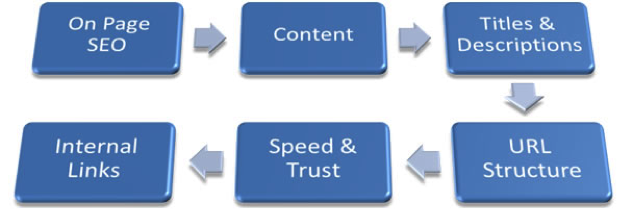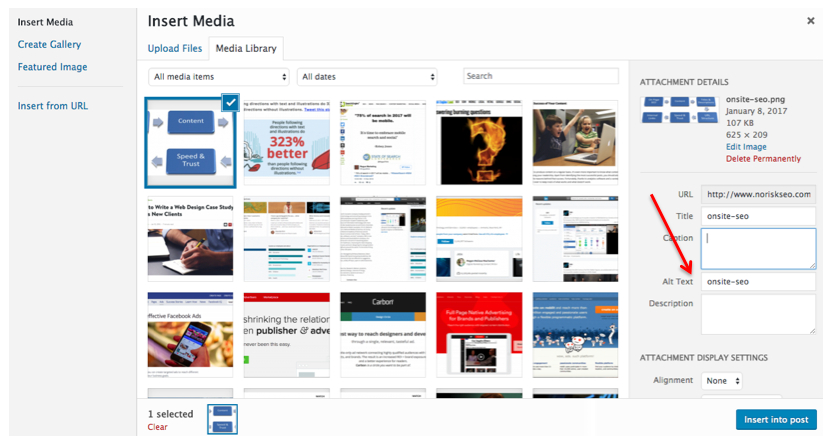When it comes to taking advantage of Search Engine Optimization (SEO), start from the inside and work your way out. Begin with making your website as search engine-friendly as possible. The easier the search engines can find important words, phrases or tags, the faster your website and content will pull through in search engine result pages (SERPs). Once you have done this, you can look to off-site SEO, such as location-based advertising, programmatic advertising, social media advertising, etc. But let’s not get ahead of ourselves—let’s talk on-site first.
On-site SEO Tips
Take a look at your page titles, article titles and descriptions first. Search engines “crawl” or search website titles and descriptions first (these are the titles and descriptions on your pages, but also the back-end descriptors and keyword tags).
Once you understand the words, phrases and tags that are used most popularly in your field, integrate them into your website.
A good rule to follow for optimizing your titles and descriptors is no more than 60 characters per title and 150 characters or less for descriptions. This will help keep the task simple for search engines to crawl your site as well as help you avoid keyword overloading, i.e., stuffing too many keywords into your descriptors in order to “outsmart” the search engines. This does not work and Google will place your site lower on the SERPs.
This is a good time to also focus on creating catchy and interesting titles. For me, it goes back to your first journalism class – get the readers attention and provide the pertinent information up front. It’s also the time to consider what your audience would search. Using a tool such as SEMRush may help you discover search queries and keywords to use in order to push your site to the top of the list.
Tags for your headlines should be used discreetly. There should be only one H1 tag (main title) on each page, followed by several H2 and H3 tags. This ensures the actual title or headline of your page is crawled first – so it’s urgent to ensure keywords are located in the H1 tag.
Alt-text for images is also important. Search engines crawl your alt-text for your images, so make sure the text is useful, descriptive and concise. Below shows where you can add alt-text for your image:
Drumroll please… Content is King
The most important way to optimize your on-site SEO is to provide quality content. Having unique, lasting content will bring your audience to you. As Digital Marketing Pro, providing “evergreen content” will differentiate your site from competitors. Evergreen content meets the following criteria:
- Unique and original
- Useful
- Relevant
- Optimized
- Proper length
- Searchable
Click here to read the full article from Digital Marketing Pro on evergreen content.
Off-site SEO Tips
Off-site SEO is the second step your SEO plan. Off-site SEO—link building and social media marketing, etc.—help build “trust” for your website while search engines crawl the web. Trust is built when the search engines continually recognize links and mentions (among others) of your content.
Link Building to Increase Off-site SEO
Algorithms are influenced from links on websites (positively or negatively) depending on if the website has a “vote of trust.” If the links are coming from low-quality websites, links will be negatively affected and vice versa.
Good marketing techniques can easily get you the natural link building you need. This all goes back to content (told you it was important!). Natural links happen when similar websites find your content, find it useful and link to it.
Get Eyes on Your Content Through Social Media Marketing
Social media marketing can be as simple or complex as you need it to be. If it is a big part of your overall SEO plan, then there are a few ways to optimize your reach through social media.
- Identify your social media goals
- Associate social media goals with business goals
- Identify your target audience
- Choose your channels
- Check out your competitors
- CONTENT
- Use the advertising networks on the channels
Your detailed plan should include:
- Specific content for your audience and when it’s scheduled
- What social media platforms you will publish on
- Budget
- Result measurement
- Team members and their roles
- Monitoring and control
Social media has become a huge part of connecting brands with audiences through marketing and advertising. A well-developed social media plan can play an integral role in your marketing communications while saving outside advertising dollars.
The Takeaway
Begin your SEO journey with everything on-site. Understand important keywords and phrases related to your company, as well as your competitors. When it comes down to it, content is the most important part of the whole conversation. Great content is your ultimate weapon. Employing your keywords and phrases within your titles, descriptions and content and your on-site SEO will improve.
Content is also an important component of your off-site SEO plan as well. Creating original, unique and useful content in your industry and natural off-site SEO and link building is bound to happen. Offering great content is bound to help your social media marketing plans as well, creating natural support through your customers.
Off-site SEO also benefits from link building, or getting your content linked on other trusted websites. Hate to be a broken record here, but that happens with great, useful content. You can do this many ways, whether naturally, or working with partners to support each other on the web can help as well—think naming and supporting your partners on your website and linking to content your customers will find useful.
Social media marketing is a fast-growing way to get your products and offerings to your audiences quickly. In order to get in front of new possible customers, you will need a budget and plan. Much of your plan should consist of your content, content schedule and result measurement. It is important to continue to look to the future to increase your online presence and connect with your customers.
Photo Credit: DigitalMarketingPro.com



